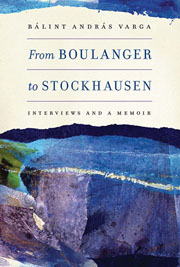Book contents
- Frontmatter
- Dedication
- Contents
- Foreword
- Acknowledgments
- Part One Interviews
- Part Two A Memoir
- Introduction
- Chapter 1 Ancestors
- Chapter 2 On Being Jewish
- Chapter 3 Growing Up in Postwar Socialist Hungary
- Chapter 4 Margit
- Chapter 5 Tapespondence
- Chapter 6 Birth and Demise of a (Counter)revolution: A Boy's-Eye View
- Chapter 7 Broadcasting 1
- Chapter 8 Broadcasting 2
- Chapter 9 Editio Musica Budapest
- Chapter 10 Interviewing: An Obsession
- Chapter 11 Ich war ein Berliner
- Chapter 12 Moving to Vienna
- Chapter 13 Universal Edition
- Chapter 14 Back Catalogue
- Chapter 15 The Psychology of Promotion
- Chapter 16 Farewell and After
- Notes in Retrospect
- Index
- Miscellaneous Endmatter
Chapter 6 - Birth and Demise of a (Counter)revolution: A Boy's-Eye View
from Part Two - A Memoir
Published online by Cambridge University Press: 05 January 2014
- Frontmatter
- Dedication
- Contents
- Foreword
- Acknowledgments
- Part One Interviews
- Part Two A Memoir
- Introduction
- Chapter 1 Ancestors
- Chapter 2 On Being Jewish
- Chapter 3 Growing Up in Postwar Socialist Hungary
- Chapter 4 Margit
- Chapter 5 Tapespondence
- Chapter 6 Birth and Demise of a (Counter)revolution: A Boy's-Eye View
- Chapter 7 Broadcasting 1
- Chapter 8 Broadcasting 2
- Chapter 9 Editio Musica Budapest
- Chapter 10 Interviewing: An Obsession
- Chapter 11 Ich war ein Berliner
- Chapter 12 Moving to Vienna
- Chapter 13 Universal Edition
- Chapter 14 Back Catalogue
- Chapter 15 The Psychology of Promotion
- Chapter 16 Farewell and After
- Notes in Retrospect
- Index
- Miscellaneous Endmatter
Summary
I cannot undertake to write an objective and exhaustive report on what we used to call, euphemistically, the “regrettable October events.” The Hungarian uprising that began on October 23, 1956, and was put down by Soviet troops on November 4 has been analyzed in a variety of ways, each according to the analyst's political affiliation. There may not be any one canon acceptable to all. What I can offer is my own personal experience.
On October 23, I went to school as usual and found the gate locked. Just one of my classmates turned up. The janitor heard us trying to get in, opened the door, and told us to go home. He could not tell us when teaching would start again.
What began as a peaceful demonstration—I saw a huge crowd slowly marching along one of Budapest's main thoroughfares and was struck by their happy faces—turned within days into an armed confrontation, with the lynching of members of the hated secret police (ÁVH—State Defense Authority). I remember the same thoroughfare about a week later with graves lining the pavement. When I stepped out onto our balcony and looked down, I saw wounded Russian soldiers in armored vehicles parked outside our house, with bloodstained dressing on their heads. Sporadic shooting was heard in the distance.
Neighbors of my parents' generation who had experienced the war as adults (it had only ended eleven years before) were wondering if they should go to the cellar, while I, on the contrary, was pounding away at the piano all day long.
- Type
- Chapter
- Information
- From Boulanger to StockhausenInterviews and a Memoir, pp. 298 - 302Publisher: Boydell & BrewerPrint publication year: 2013



